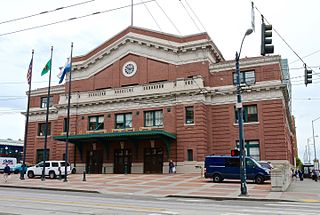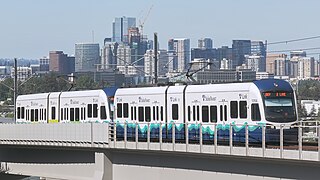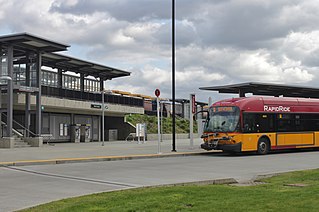
Snohomish County is a county located in the U.S. state of Washington. With a population of 827,957 as of the 2020 census, it is the third-most populous county in Washington, after nearby King and Pierce counties, and the 72nd-most populous in the United States. The county seat and largest city is Everett. The county forms part of the Seattle metropolitan area, which also includes King and Pierce counties to the south.

The Seattle metropolitan area is an urban conglomeration in the U.S. state of Washington that comprises Seattle, its surrounding satellites and suburbs. The United States Census Bureau defines the Seattle–Tacoma–Bellevue, WA metropolitan statistical area as the three most populous counties in the state: King, Pierce, and Snohomish. Seattle has the 15th largest metropolitan statistical area (MSA) in the United States with a population of 4,018,762 as of the 2020 census, over half of Washington's total population.

Sound Transit (ST), officially the Central Puget Sound Regional Transit Authority, is a public transit agency serving the Seattle metropolitan area in the U.S. state of Washington. It operates the Link light rail system in Seattle and Tacoma, regional Sounder commuter rail, and Sound Transit Express bus service. The agency also coordinates the regional ORCA fare card system, which is also used by local transit operators. In 2019, Sound Transit services carried a total of 48 million passengers and averaged over 161,000 riders on weekdays.

Community Transit (CT) is the public transit authority of Snohomish County, Washington, United States, excluding the city of Everett, in the Seattle metropolitan area. It operates local bus, paratransit and vanpool service within Snohomish County, as well as commuter buses to Downtown Seattle and Northgate station. CT is publicly funded, financed through sales taxes, and farebox revenue, with an operating budget of $133.2 million. In 2023, the system had a ridership of 7,133,700, or about 24,400 per weekday as of the fourth quarter of 2023, placing it fourth among transit agencies in the Puget Sound region. The city of Everett, which serves as the county seat, is served by Everett Transit, a municipal transit system.

Transportation in Seattle is largely focused on the automobile like many other cities in western North America; however, the city is just old enough for its layout to reflect the age when railways and trolleys predominated. These older modes of transportation were made for a relatively well-defined downtown area and strong neighborhoods at the end of several former streetcar lines, now mostly bus lines.

The 1 Line, formerly Central Link, is a light rail line in Seattle, Washington, United States, and part of Sound Transit's Link light rail system. It serves 19 stations in the cities of Seattle, SeaTac, and Tukwila, traveling nearly 25 miles (40 km) between Northgate and Angle Lake stations. The line connects the University District, Downtown Seattle, the Rainier Valley, and Seattle–Tacoma International Airport. The 1 Line carried over 26 million total passengers in 2023, with an average of nearly 80,000 daily passengers on weekdays. It runs for 20 hours per day on weekdays and Saturdays, with headways as low as six minutes during peak hours, and reduced 18-hour service on Sundays and holidays.

Everett Station is an Amtrak train station serving the city of Everett, Washington, United States. The station has provided service to the Cascades and Empire Builder routes since its opening in 2002, replacing an earlier station near the Port of Everett. The four-story building also houses social service programs and is the center of a 10-acre (4 ha) complex that includes parking lots and a large bus station used primarily by Community Transit, Everett Transit, and Sound Transit Express. The station has served as the northern terminus of the Sounder N Line since 2003 and the Swift Blue Line since 2009. It consists of two side platforms, one serving Amtrak and the other serving Sounder commuter trains. Everett Station also functions as a park and ride, with 1,067 short-term parking spaces located in lots around the station after it was expanded by Sound Transit in 2009.

Link light rail is a light rail rapid transit system serving the Seattle metropolitan area in the U.S. state of Washington. It is managed by Sound Transit in partnership with local transit providers, and consists of three non-connected lines: the 1 Line in King County, which travels for 26 miles (42 km) between Seattle and Seattle–Tacoma International Airport; the 2 Line in King County's Eastside region between Bellevue and Redmond; and the T Line in Pierce County, which runs for 4 miles (6.4 km) between Downtown Tacoma and Tacoma Dome Station. In 2023, the system had a ridership of 23.9 million, or about 78,600 per weekday as of the fourth quarter of 2023, primarily on the 1 Line. Trains run at frequencies of 6 to 24 minutes.

Sound Transit Express is a network of regional express buses, operated by the multi-county transit agency, Sound Transit. The routes connect major regional hubs throughout 53 cities in three counties in the Puget Sound region. Sound Transit Express ranks first in the nation in the number of commuter bus passengers carried and in vehicle miles driven. The first nine routes and 114 buses began carrying passengers on September 19, 1999. In 2023, the system had a ridership of 8,565,100, or about 29,000 per weekday as of the fourth quarter of 2023.

The 2 Line, also known as the East Link Extension, is a light rail line serving the Eastside region of the Seattle metropolitan area in the U.S. state of Washington. It is part of Sound Transit's Link light rail system and runs for 6.6 miles (10.6 km) in the cities of Bellevue and Redmond. The initial segment serves eight stations between South Bellevue and Redmond Technology stations and opened on April 27, 2024. The full line is scheduled to open in 2025 and is planned to include 18 miles (29 km) from west to east and serve twelve stations in Downtown Seattle, Mercer Island, Bellevue, and Redmond. The 2 Line will continue through the Downtown Seattle Transit Tunnel and share stations with the 1 Line through to Lynnwood City Center station.
The Puget Sound Regional Council (PSRC) is a metropolitan planning organization that develops policies and makes decisions about transportation planning, economic development, and growth management throughout the four-county Seattle metropolitan area surrounding Puget Sound. It is a forum for cities, towns, counties, transit agencies, port districts, Native American tribes, and state agencies to address regional issues.

Tukwila station is a train station in Tukwila, Washington, United States. The station was built by Sound Transit to serve its Sounder commuter rail service on the S Line, as well as Amtrak's intercity Cascades line. It includes 390 parking spaces and a bus platform served by King County Metro's RapidRide F Line and other routes.

Link light rail in the Seattle metropolitan area of Washington is a light rail system managed by Sound Transit since its inception in 1996. As of 2024, it consists of the 1 Line and T Line; the 2 Line is under construction and other lines are in planning.

Frederick Kemper Freeman Jr. is the active chairman and CEO of Kemper Development Company, which built and operates Bellevue Square, Bellevue Place, and Lincoln Square, all located in Bellevue, Washington. Kemper represents the third generation of the Freeman family, who have been involved in the growth of the Bellevue community since 1897. He is a former Republican member of the Washington State House of Representatives from the 48th district and publicly active in conversations about traffic and transportation in Bellevue.

Lakewood station is a commuter rail station in Lakewood, Washington, United States. It is the terminus of the S Line of the Sounder commuter rail network, operated by Sound Transit in the Seattle metropolitan area. The station, located along Pacific Highway Southwest, includes a 620-stall parking garage and several bus bays served by Intercity Transit and Sound Transit Express. Lakewood station was originally scheduled to open in 2002 as part of a Sounder extension, but plans were delayed due to funding issues and the state government's work on the Point Defiance Bypass project. Construction on the $33 million station and garage began in March 2007 and it opened for use by buses on September 18, 2008. Sounder service to Lakewood began in October 2012 and the pedestrian bridge opened a few months later.

Mountlake Terrace Transit Center is a bus station and future light rail station in Mountlake Terrace, Washington.

Sound Transit 3, abbreviated as ST3, was a ballot measure during the November 2016 elections in Seattle, Washington, proposing an expansion of the regional public transit system. The measure was proposed by Sound Transit, which was established by a similar initiative passed in 1996 and expanded by the Sound Transit 2 vote in 2008, who have operated regional transit systems in the Seattle metropolitan area since 1999. On November 8, 2016, Sound Transit 3 was approved by over 54 percent of voters in the Puget Sound region; voters in Pierce County rejected the measure, but the measure passed in King and Snohomish counties, and had an overall majority.

The SODO Busway, also referred to as the E-3 Busway, is a 1.5-mile-long (2.4 km) busway in the SoDo neighborhood of Seattle, Washington. It has four stops, including two that connect to Link light rail stations, and functions as an extension of the Downtown Seattle Transit Tunnel, which was formerly used by buses. The busway is served by ten bus routes—seven King County Metro routes from southern King County and three Sound Transit Express routes from Pierce County.

The Point Defiance Bypass is a 14.5-mile-long (23.3 km) rail line between the cities of DuPont and Tacoma in Pierce County, Washington. It was originally built by the Northern Pacific Railway – the Tacoma–Lakewood segment in 1874 as part of the Prairie Line, and the Lakewood–DuPont section in 1891. Passenger service on the lines declined after the 1914 completion of a flatter route along Puget Sound, and ended entirely in 1956.

















